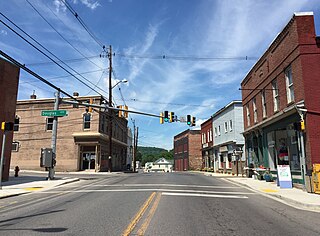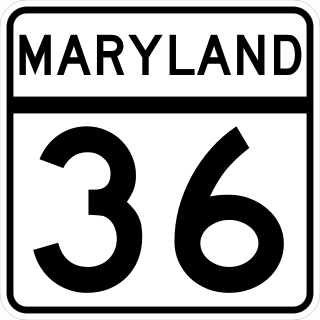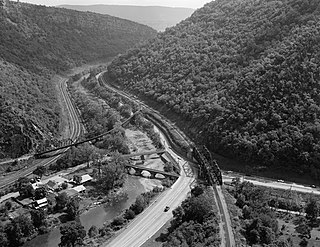
Frostburg is a city in Allegany County, Maryland. It is located at the head of the Georges Creek Valley, 8 miles (13 km) west of Cumberland. The town is one of the first cities on the "National Road", US 40, and the western terminus of the Western Maryland Scenic Railroad. It is part of the Cumberland metropolitan area,

Lonaconing is a town in Allegany County, Maryland, United States, located along the Georges Creek Valley. It is part of the Cumberland, MD-WV Metropolitan Statistical Area. The population was 1,214 at the 2010 census.

The Western Maryland Railway was an American Class I railroad (1852–1983) that operated in Maryland, West Virginia, and Pennsylvania. It was primarily a coal hauling and freight railroad, with a small passenger train operation.

The Western Maryland Scenic Railroad (WMSR) is a heritage railroad based in Cumberland, Maryland, that operates passenger excursion trains and occasional freight trains using both steam and diesel locomotives over ex-Western Maryland Railway (WM) tracks between Cumberland and Frostburg. The railroad offers coach and first class service, murder mystery excursions, and special seasonal trips.

Maryland Route 36 is a 29.43-mile (47.36 km) state highway located in Allegany County, Maryland, United States. MD 36's southern terminus is at the West Virginia Route 46 (WV 46) bridge in Westernport and its northern terminus at U.S. Route 40 Alternate near Cumberland. Between Westernport and Frostburg, it is known as Georges Creek Road, and from Frostburg to Cumberland it is known as Mount Savage Road. Like the majority of Maryland state highways, MD 36 is maintained by the Maryland State Highway Administration (MDSHA).

Mount Savage is an unincorporated community and census-designated place (CDP) in Allegany County, Maryland, United States. As of the 2010 census it had a population of 873.

The Maryland Mining Company is a historic coal mining, iron producer and railroad company that operated in Allegany County, Maryland, United States.

The Eckhart Branch Railroad was a railroad that operated in the Cumberland, Maryland area in the 19th century.
The Mount Savage Railroad was a railroad operated by the Maryland and New York Coal and Iron Company of Mount Savage, Maryland between 1845 and 1854. The 14.9 miles (24 km) rail line ran from Frostburg to Cumberland, Maryland.
The Georges Creek Railroad was a railroad operated by the Georges Creek Coal and Iron Company in Western Maryland. The railroad operated from 1853 to 1863, when it was acquired by the Cumberland and Pennsylvania Railroad (C&P).
The Georges Creek Coal and Iron Company is a defunct coal mining, iron producer and railroad company that operated in Maryland from 1835 to 1863.
The Georges Creek and Cumberland Railroad (GC&C) was a railroad that operated in Maryland from 1876 until 1917, when it was merged with the Western Maryland Railway (WM). The main line ran from Cumberland to Lonaconing.
The Mount Savage Locomotive Works was a railroad workshop established at Mount Savage, Maryland, US. The Cumberland and Pennsylvania Railroad locomotive shops were established in Mt. Savage in 1866, under the direction of James Millholland. The original locomotive shop was constructed of stone and was 90 feet x 250 feet in size with a 33-foot-high roof. An adjoining car shop, built at about the same time, was also of stone and was later extended with a wooden structure. These buildings still stand in Mt. Savage.
The Potomac Wharf Branch was a historic railroad located in Maryland. It was built by the Maryland Mining Company between 1846 and 1850, as an extension to the Eckhart Branch Railroad. The Potomac Wharf Branch crossed Wills Creek on a bridge just east of the present Route 40 road bridge near Cumberland. Rail tracks from this line may still be seen near some billboards, and a gas station in that area.
The West Virginia Central and Pittsburg Railway (WVC&P) was a railroad in West Virginia and Maryland operating in the late 19th and early 20th centuries. It had main lines radiating from Elkins, West Virginia in four principal directions: north to Cumberland, Maryland; west to Belington, WV; south to Huttonsville, WV; and east to Durbin, WV. Some of the routes were constructed through subsidiary companies, the Piedmont and Cumberland Railway and the Coal and Iron Railway.
The Mount Savage Iron Works operated from 1837 to 1868 in Mount Savage, Maryland. The ironworks were the largest in the United States in the late 1840s, and the first in the nation to produce heavy rails for construction of railroads. The works were established in an area adjacent to mines for coal, iron ore and fire clay. Facilities included blast furnaces, puddling furnaces, a rolling mill, iron refineries, coke production and brick production.
Thomas Haig Paul was a locomotive manufacturer in Frostburg, Maryland, in the 19th Century. He is credited with building the first narrow-gauge locomotive in the United States in 1864.
Georges Creek may refer to:
The Pennsylvania Railroad in Maryland company was organized in 1876. According to its charter, it was to run from Cumberland, Maryland to the Pennsylvania line where it would connect with other branches of the Pennsylvania Railroad system and provide another outlet for Maryland's soft coal to the major industrial cities. The railroad had also been promoted by coal companies in the Georges creek valley in Maryland, principally the Maryland Coal Company and the American Coal Company as well as the city of Cumberland, Maryland to provide "the benefit of a competitive road with the Baltimore and Ohio railroad, then its only outlet." The Pennsylvania railroad wanted access to the Georges creek valley coal and potential customers such as the Maryland and American coal companies. To do so, meant bypassing the Cumberland and Pennsylvania railroad which was controlled by the Consolidation Coal company, the largest bituminous coal company in the eastern United States. In 1873, the Baltimore and Ohio railroad had purchased a majority of the Consolidation Coal company's stock, thereby controlling coal exports out of the Georges creek valley and effectively the "entire output of coal in ."

Western Maryland Scenic Railroad No. 734, also known as Mountain Thunder, is an SC-1 class 2-8-0 “Construction” type steam locomotive originally built by the Baldwin Locomotive Works in 1916 for the Lake Superior & Ishpeming Railroad (LS&I) as No. 18. It was renumbered to 34 in 1925.











